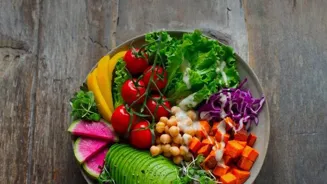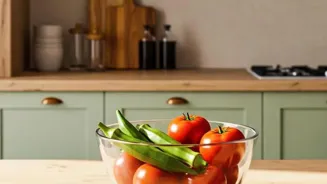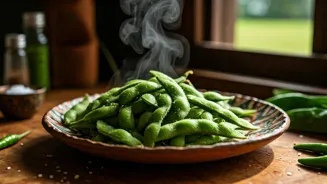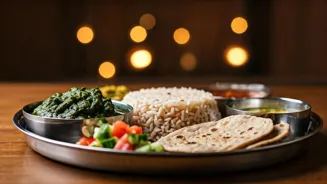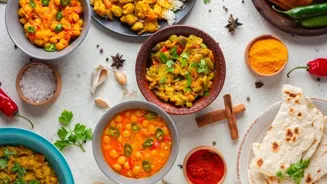Discover 10 Essential Tips for Healthy Meal Prep in India. Elevate your eating habits effortlessly!
In today's 'bhagam-bhag' life, balancing work, family and personal well-being can feel like a circus act.
Somewhere in between chasing deadlines and managing the household, eating healthy often takes a backseat.
But fret not, because meal preparation, or meal prep as the cool kids call it, is here to be your personal superhero! It's all about planning and preparing your meals in advance, saving you time, money, and most importantly, helping you achieve your health goals.
So, ditch the last-minute samosa runs and get ready to embrace the wonderful world of healthy meal prep.
Meal prepping transforms eating habits for health & convenience
Meal prepping isn't just about chopping vegetables on a Sunday afternoon. It's a comprehensive approach to eating well and feeling great. It involves planning your meals for the week, shopping smart, prepping ingredients, cooking in batches, and storing your food properly.
Think of it as a well-organized kitchen army, ready to conquer your hunger pangs with delicious and nutritious food. By taking charge of your meals, you're not just eating healthier, you're also gaining control over your time and budget. It's a win-win situation!
In a country like India, where 'ghar ka khana' is often considered the gold standard of health, meal prep allows you to bring the goodness of home-cooked meals to your busy weekdays.
Plan your meals strategically to meet health goals with Indian cuisine
Before you even think about reaching for that knife and chopping board, sit down and plan your meals for the week. Think about what you like to eat, what ingredients you already have, and what your health goals are. Are you aiming to eat more vegetables? Reduce your sugar intake? Load up on protein?
Your meal plan should reflect your personal preferences and needs. Indian cuisine offers a plethora of healthy and delicious options perfect for meal prepping. Think lentil soups, vegetable curries, rice dishes with plenty of veggies, and healthy salads.
A good practice is to have a whiteboard somewhere in your kitchen and write down your meal palns. This would help you and other family members remain aware of what to eat and when.
Get creative with meal planning, explore recipes, use leftovers, control portions
Don't be afraid to get creative with your meal plan. Browse through cookbooks, explore online recipes, and experiment with different flavors and ingredients. Variety is the spice of life, and it's also key to sticking to your meal prep routine.
Also, while creating plan, ensure that if you’re planning a meal with dhal and rice for monday and rice on tuesday, you can use the rice from monday and temper it for tuesday. This promotes both planning and saving a lot of time and energy. And let's not forget the importance of portion control.
Use measuring containers and bowls to ensure that you're eating the right amount of food.
Plan meals, make list, shop smart for fresh, healthy foods
Once you have your meal plan in place, it's time to hit the grocery store. But before you do, make a detailed shopping list based on your recipes. This will help you avoid impulse purchases and stay focused on buying only what you need.
Check your pantry and refrigerator to see what ingredients you already have. This will prevent you from buying duplicates and wasting food. When shopping, prioritize fresh produce, whole grains, and lean protein sources.
Look for seasonal fruits and vegetables, as they are often cheaper and taste better. If possible, try shopping at local farmers' markets for the freshest and most affordable options.
Frozen fruits and veggies are nutritious; read labels, shop smart, involve kids
Don't be afraid to buy frozen fruits and vegetables. They are just as nutritious as fresh ones and can be a lifesaver when you're short on time. And remember to read the labels carefully. Avoid products that are high in sodium, sugar, and unhealthy fats.
Stock up on healthy snacks like nuts, seeds, and dried fruits to keep you satisfied between meals. Shopping smart is all about being organized, informed, and mindful of your budget and health goals. It is best if you engage your kids as well to get them used to what is inside your meal prep plan.
Prep ingredients efficiently for easy meal prep
Now comes the fun part: prepping your ingredients! This is where you'll be doing all the chopping, slicing, dicing, and grating. It may seem like a lot of work upfront, but trust me, it will save you tons of time during the week. Wash and chop all your vegetables and fruits.
Store them in airtight containers in the refrigerator. Pre-cook grains like rice and quinoa. Portion them out into individual containers for easy meal assembly. Marinate your tofu or paneer for added flavor. Roast a batch of vegetables for a quick and healthy side dish.
Involving family in meal prep for Indian dishes
Get the whole family involved. Let your kids help with simple tasks like washing vegetables or measuring ingredients. This is a great way to teach them about healthy eating and get them involved in the cooking process. Put on some music or a podcast to make the prepping process more enjoyable.
Remember, the goal is to make meal prep a sustainable and enjoyable part of your routine, not a chore you dread. This is most useful while preparing indian meals since we would have to prep ingredients.
Cook in batches for efficient meal prep: save time and energy
Cooking in batches is the key to efficient meal prep. Instead of cooking single servings of food each day, cook large quantities of your meals at once. This will save you time, energy, and washing-up. Make a big pot of lentil stew or sambar that you can enjoy throughout the week.
Roast a tray of mixed vegetables that can be added to salads, wraps, or bowls. Cook a large batch of rice or quinoa to use as a base for different meals.
Double recipes for future meals, freeze for convenience
Don't be afraid to double or triple your favorite recipes. Freeze the extras for future meals. Use your slow cooker or pressure cooker to make large batches of soups, stews, and curries. These appliances are perfect for busy weeknights.
And remember to label your containers with the date and contents. This will help you keep track of what you have in the refrigerator and freezer. When you have time, cook in bigger batches and freeze to use on days when you have even lesser time.
Proper food storage tips for meal prepping
Proper food storage is essential for maintaining the quality and safety of your meal prepped meals. Invest in a good set of airtight containers. These will keep your food fresh and prevent it from drying out or absorbing odors in the refrigerator.
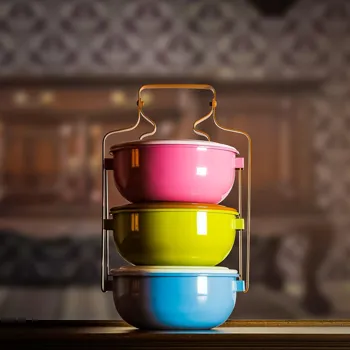
Use glass containers for storing acidic foods like tomatoes and citrus fruits. Store raw and cooked foods separately to prevent cross-contamination. Label each container with the date and contents. This will help you keep track of when you need to use the food.
Properly store meal prepped meals for freshness
Store your meal prepped meals in the refrigerator for up to four days. For longer storage, freeze your meals in individual portions. When freezing food, make sure to cool it down completely before placing it in the freezer.
This will prevent ice crystals from forming and affecting the texture of the food. Thaw frozen meals in the refrigerator overnight or in the microwave using the defrost setting. Ensure you use your refrigerator and freezer optimally to make every bit of it useful.
Spice up meals with Indian flavors and herbs
Don't let your meal prepped meals get boring! Experiment with different spices and herbs to add flavour and excitement to your dishes. Indian cuisine is known for its bold and aromatic flavours. Use spices like turmeric, cumin, coriander, ginger, and garlic to create delicious and healthy meals.
Add a touch of chilli powder for a spicy kick. Use fresh herbs like cilantro, mint, and parsley to add freshness and vibrancy to your dishes.
Experiment with chutneys and sauces for flavorful meal preps
Experiment with different chutneys and sauces. They can add a burst of flavour to your meal prepped meals. Try a mango chutney, a mint-coriander chutney, or a tamarind chutney. Use lemon juice or vinegar to add a tangy flavour to your salads and vegetable dishes.
Don't be afraid to get creative and experiment with different flavour combinations. The possibilities are endless! So, get cooking, experiment with flavours, and enjoy the delicious and healthy benefits of meal prep! These tips are designed to help you in the long run!
Rotate recipes, use varied ingredients for diverse meals
To avoid meals getting boring, create a rotation of recipes. Take the help of the internet or ask your friends and families for recipes and repeat recipes after regular intervals. To avoid eating the same food, use one ingredient in multiple forms.
For instance, boil some potatoes and on day 1, you can eat it as is with some salt and pepper. On the second day, you can prepare aloo tikki by mashing it with spices.
Repurpose leftovers for efficient meal prepping
To make the most of meal prepping, repurpose all your leftovers. Use your left over cooked vegetables to add it with your salads or boil them in soups for adding nutrients. Left over rice can be converted to fried rice.
Similarly, left over breads can be converted to bread crumbs and used for tikkis or cutlets. This way, nothing is wasted and optimum nutrition is ensured.
Eat diverse salads daily for high fiber, metabolism, nutrients
Have lots of salads made available and eat them with lots of meals. Salads provide fiber and keep your metabolism high. Also, keep them fresh and ensure that you rotate with items like spinach, cucumber, tomatoes and cabbages.
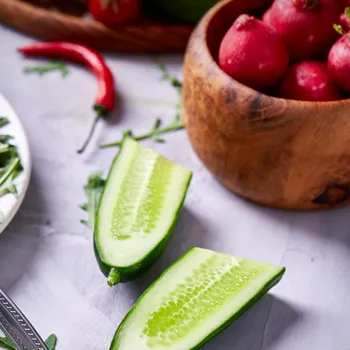
This ensures that your salad doesn't become boring and you get every nutrient. This becomes even more important if you are on a fatloss diet.
Plan healthy snacks like fruits, nuts, and protein bars for successful meal prep
While planning meal prep, you need to ensure that you also have lots of healthy snacks. Some great healthy snacks option include Protein bars, fruits, popcorns and peanuts. Avoid keeping snacks such as wafers and chips as they tend to have a lot of unhealthy contents. This way, you can avoid eating high calorie items and can stick to your diet for longer time
AI Generated Content. Glance/InMobi shall have no liability for the content
